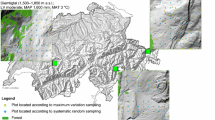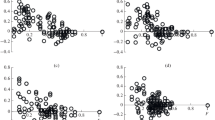Abstract
Variation in the number of species was studied in a subthermophilous grassland at a scale of 0.05 ×0.05 m during a 5-year period. The observed variance of species richness (VSR) was compared with a null model based on random distribution of species over a set of squares. It was found that distribution of species richness had more values than, expected around the mean and less values at the “shoulders”. Both tails fell within the predicted limits. Application of the procedures removing spatial dependence (random shifts, rotation/reflection method byPalmer & van der Maarel 1995) and environmental heterogeneity (patch model byWatkins & Wilson 1992) did not change the observed pattern.
Using simulations in which the number of clumps and clumping intensity were manipulated it was found that the effect of the clumped spatial pattern, on VSR results in a wide range of variances. Both variance excess and variance deficit were found more frequently than expected under the null model.
To test the effect of the limitation to the number of individuals per square, a null model was developed which included that observed number of plant shoots per square, the observed distribution of the number of shoots belonging to individual species per square and the observed spatial distribution of the shoots. The observed VSR was still lower than that produced by the null model. Therefore, it is concluded that at a scale of 0.05×0.05 m plant species combine in a non-random way in the studied grassland. It is suggested that the shape of left and right “shoulders” of the species richness distribution may be caused by different factors, such as positive and negative covariance between species, respectively. Their simultaneous impact can generate the observed pattern in species richness.
Similar content being viewed by others
References
Aarssen L.W. &Epp G.A. (1990): Neighbor manipulations in natural vegetation: a review.—J. Veg. Sci. 1: 13–30.
Bartha S., Collins S.L., Glenn S.M. &Kertész M. (1995a): Fine-scale spatial organization of tallgrass prairie vegetation along a topographic gradient.—Folia Geobot. Phytotax. 30: 169–184.
Bartha S., Czárán T. &Oborny B. (1995b): Spatial constraints masking community assembly rules: a simulation study.—Folia Geobot. Phytotax. 30: 471–482.
Bertness M.D. &Callaway R. (1994): Positive interactions in communities. —Trends Ecol. Evol. 9: 191–193.
Bycroft C.M., Nicolasou N., Smith B. &Wilson B. (1993): Community structure (niche limitation and guild proportionality) in relation to the effect of spatial scale, in aNothofagus forest sampled with a circular transect.—New Zealand J. Ecol. 17: 59–65.
Caldwell M.M. &Pearcy R.W. (1994) [eds.]: Exploitation of environmental heterogeneity by plants.— Academic Press, San Diego.
Cale W.G., Henebry M. &Yeakley J.A. (1989): Inferring process from pattern in natural communities.—BioScience 39: 600–605.
Clements F.E. (1916): Plant succession: an analysis of the development of vegetation.—Carnegie Inst., Washington, Publ. No. 242.
Grace J.B. &Tilman D. (1990) [eds] Perspectives on plant competition.—Academic Press, San Diego.
Greig-Smith P. (1983): Quantitative plant ecology. Ed 3.—University of California Press, Berkeley.
Goldberg D. (1995): Generating and testing predictions about community structure: which theory is relevant and can it be tested with observational data?—Folia Geobot. Phytotax. 30: 511–518.
Harvey P.H., Colwell R.K., Silvertown J.W. &May R.M. (1983): Null models in ecology. —Annual Rev. Ecol. Syst. 14: 189–211.
Herben T., Krahulec F., Hadincová V. &Kovářová M. (1993): Small-scale spatial dynamics of plant species in a grassland community over six years.—J. Veg. Sci. 4: 171–178.
Hunter A.F. &Aarssen L.W. (1988): Plants helping plants: New evidence indicates that beneficence is important in vegetation.—BioScience 38: 34–40.
Jongman R.H., ter Braak C.J.F. &van Tongeren O.F.R. (1987): Data analysis in community and landscape ecology.—Wageningen, Pudoc, 299 pp.
Jongepierová I., Jongepier J.W. &Klimeš L. (1994): Restoration of species-rich meadows in the Bílé Karpaty Moutains.—Příroda 1: 185–189.
Klimeš L., Jongepier J.W. &Jongepierová I. (1995). Niche limitation, guild structure and small-scale dynamics in species-rich meadows.—Folia Geobot. Phytotax. 30: 243–253.
Lepš J. (1995): Variance deficit is not reliable evidence for niche limitation.—Folia Geobot. Phytotax. 30: 455–459.
Lepš J. &Štursa J. (1989): Species-area curve, life history strategies, and succession: a field test of relationships.—Vegetatio 83: 249–257.
Marsaglia G., Narasimhan B. &Zaman A. (1990): A random number generator for PC’s.—Comp. Physics Comm. 60: 345–349.
McConnaughay K.D.M. &Bazzaz F.A. (1991): Is physical space a soil resource?.—Ecology 72: 94–103.
McIntosh R.P. (1981). Succession and ecological theory..—In:West D.C., Shugart H.H. &Botkin D.B. [eds.]: Forest succession: Concepts and applications.—Springer-Verlag, New York pp. 10–23.
Palmer M.W. (1987): Variability in species richness within Minnesota oldfields: a use of the variance test.— Vegetatio 70: 61–64.
Palmer M.W. &van der Maarel E. (1995): Variance in species richness, species association and niche limitation.—Oikos 73: 203–213.
Pickett S.T.A. &McDonnell M.J. (1989): Changing perspectives in community dynamics: a theory of successional forces.—Trends Ecol. Evol. 4: 241–245.
Rabotnov T.A. (1992): Javljaetsja li ob’’em fizičeskoj sredy resursom dlja rastenij? (Is physical space a resource for plants?).—Bjull. Moskovsk. Obšč. Isp. Prir., Otd. Biol. 97(5): 81–82.
Ryser P. (1990): Influence of gaps and neighbouring plants on seedling establishment in limestone grasslands. —Veröff. Geobot. Inst. ETH, Stiftung Rübel, Zürich, 104.
Ryser P. (1993): Influences of neighbouring plants on seedling establishment in limestone grassland.—J. Veg. Sci. 4: 195–202.
Schluter D. (1984): A variance test for detecting species associations, with some example applications.— Ecology 65: 998–1005.
Tlusták V. (1975): Syntaxonomický, přehled travinných společenstev Bílých Karpat (Syntaxonomical survey of grasslands in the Bílé Karpaty Mountains).—Preslia 47: 129–144.
Utkin A.I., Byastrov L.G., Dylis N.V. &Solntseva O.N. (1969): Vertikal’no-frakcionnoe raspredelenie fitomassy i principy vydelenija biogeogorizontov v lesnych biogeocenozah (Vertical-fractional distribution of biomass and principles of recognition of biogeohorizons in forest biocenoses).—Bjull. Moskovsk. Obšč. Isp. Prir., Otd. Biol. 74(1): 85–100.
Van der Maarel E. &Sykes M.T. (1993): Small-scale plant species turnover in a limestone grassland: the carousel model and some comments on the niche concept.—J. Veget Sci. 4: 179–188.
Watkins A.J. &Wilson J.B. (1992): Fine-scale community structure of lawns.—J. Ecol. 80: 15–24.
Wilson J.B. (1995a): Variance in species richness, niche limitation, and vindication of patch models.—Oikos 73: 277–279.
Wilson J.B. (1995b): Testing for community structure: a Bayesian approach.—Folia Geobot. Phytotax. 30: 461–469.
Wilson J.B., Gitay H. &Agnew A.D.Q. (1987): Does niche limitation exist?—Funct. Ecol. 1: 391–397.
Wilson J.B., Roxburgh S.H. &Watkins A.J. (1992): Limitation, to plant species coexistence at a point: a study in a New Zealand lawn.—J. Veg. Sci. 3:711–714.
Author information
Authors and Affiliations
Rights and permissions
About this article
Cite this article
Klimeš, L. Small-scale distribution of species richness in a grassland (Bílé Karpaty Mts., Czech Republic). Folia Geobot 30, 499–510 (1995). https://doi.org/10.1007/BF02803979
Issue Date:
DOI: https://doi.org/10.1007/BF02803979




